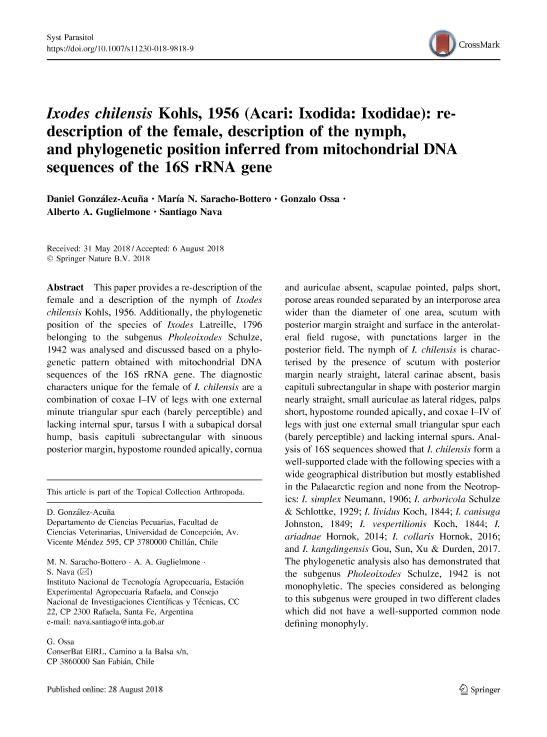Artículo
Ixodes chilensis Kohls, 1956 (Acari: Ixodida: Ixodidae): re-description of the female, description of the nymph, and phylogenetic position inferred from mitochondrial DNA sequences of the 16S rRNA gene
González Acuña, Daniel; Saracho Bottero, María Noelia ; Ossa, Gonzalo; Guglielmone, Alberto Alejandro
; Ossa, Gonzalo; Guglielmone, Alberto Alejandro ; Nava, Santiago
; Nava, Santiago
 ; Ossa, Gonzalo; Guglielmone, Alberto Alejandro
; Ossa, Gonzalo; Guglielmone, Alberto Alejandro ; Nava, Santiago
; Nava, Santiago
Fecha de publicación:
11/2018
Editorial:
Springer
Revista:
Systematic Parasitology
ISSN:
0165-5752
e-ISSN:
1573-5192
Idioma:
Inglés
Tipo de recurso:
Artículo publicado
Clasificación temática:
Resumen
This paper provides a re-description of the female and a description of the nymph of Ixodes chilensis Kohls, 1956. Additionally, the phylogenetic position of the species of Ixodes Latreille, 1796 belonging to the subgenus Pholeoixodes Schulze, 1942 was analysed and discussed based on a phylogenetic pattern obtained with mitochondrial DNA sequences of the 16S rRNA gene. The diagnostic characters unique for the female of I. chilensis are a combination of coxae I–IV of legs with one external minute triangular spur each (barely perceptible) and lacking internal spur, tarsus I with a subapical dorsal hump, basis capituli subrectangular with sinuous posterior margin, hypostome rounded apically, cornua and auriculae absent, scapulae pointed, palps short, porose areas rounded separated by an interporose area wider than the diameter of one area, scutum with posterior margin straight and surface in the anterolateral field rugose, with punctations larger in the posterior field. The nymph of I. chilensis is characterised by the presence of scutum with posterior margin nearly straight, lateral carinae absent, basis capituli subrectangular in shape with posterior margin nearly straight, small auriculae as lateral ridges, palps short, hypostome rounded apically, and coxae I–IV of legs with just one external small triangular spur each (barely perceptible) and lacking internal spurs. Analysis of 16S sequences showed that I. chilensis form a well-supported clade with the following species with a wide geographical distribution but mostly established in the Palaearctic region and none from the Neotropics: I. simplex Neumann, 1906; I. arboricola Schulze & Schlottke, 1929; I. lividus Koch, 1844; I. canisuga Johnston, 1849; I. vespertilionis Koch, 1844; I. ariadnae Hornok, 2014; I. collaris Hornok, 2016; and I. kangdingensis Gou, Sun, Xu & Durden, 2017. The phylogenetic analysis also has demonstrated that the subgenus Pholeoixodes Schulze, 1942 is not monophyletic. The species considered as belonging to this subgenus were grouped in two different clades which did not have a well-supported common node defining monophyly.
Palabras clave:
IXODES
,
PHYLOGENETIC POSITION
,
DISTRIBUTION
,
PALAEARCTIC
Archivos asociados
Licencia
Identificadores
Colecciones
Articulos(CCT - SANTA FE)
Articulos de CTRO.CIENTIFICO TECNOL.CONICET - SANTA FE
Articulos de CTRO.CIENTIFICO TECNOL.CONICET - SANTA FE
Citación
González Acuña, Daniel; Saracho Bottero, María Noelia; Ossa, Gonzalo; Guglielmone, Alberto Alejandro; Nava, Santiago; Ixodes chilensis Kohls, 1956 (Acari: Ixodida: Ixodidae): re-description of the female, description of the nymph, and phylogenetic position inferred from mitochondrial DNA sequences of the 16S rRNA gene; Springer; Systematic Parasitology; 95; 8-9; 11-2018; 959-967
Compartir
Altmétricas



